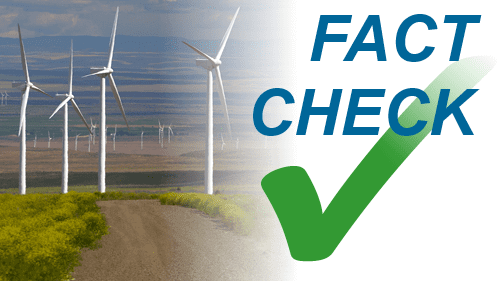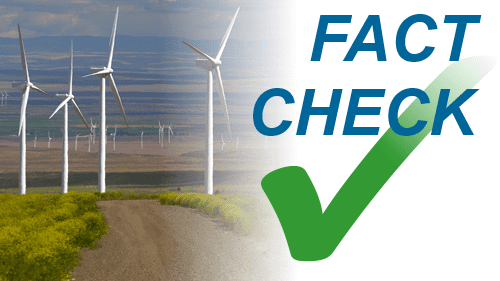Fact check: Silverstein errs on wind's variability, emissions cuts
In a recent article at Forbes.com, Energy Central Editor Ken Silverstein raised questions about wind's variability and its ability to reduce emissions.
It is a common misconception to think that the variability of renewable resources is a unique challenge for grid operators. The reality is that utility system operators are constantly dealing with massive swings in electricity demand and in the output of conventional generators. Electricity demand varies by a factor of three or more depending on the time of day and year, and it is common for large nuclear and fossil power plants to experience sudden outages that take 1000 megawatts (MW) (enough to power 1 million homes) or more of generation offline with no warning. System operators deal with this variability in supply and demand by changing the output of flexible resources, such as hydroelectric and natural gas power plants that can change their output level and store their fuel behind the dam or in the gas pipeline, as well as activating demand response resources (businesses that pay a reduced rate for electricity in exchange for allowing temporary interruptions in supply).
In many ways, the variability of wind and solar resource is easier to deal with than other types of variability on the power system. When wind and solar plants are spread over a large geographic area, as they are in the U.S., their output becomes far smoother and more predictable. This makes sense, as a weather event affecting one wind plant will take many hours to reach a wind plant hundreds of miles away, by which point the first wind plant would at many times be experiencing an opposite change in output; data from real-world wind plants confirms this powerful canceling-out effect. Moreover, wind power forecasting has become remarkably adept at accurately predicting wind output a day or more in advance, with forecast errors that also tend to cancel out across larger geographic regions.
The critical difference between the variability of wind and solar plants and that of conventional power plants is that renewable output changes slowly and predictably, while failures at conventional power plants occur instantaneously and without warning. As a result, it is more appropriate to talk about the need for grid operators to back up a large conventional generator than it is to talk about backing up renewable resources. Importantly, the fast-acting reserves that system operators must have on standby 24/7/365 in case a conventional generator experiences an outage typically cost 40 times more than the slower-acting reserves that are best suited for accommodating the slower variability of wind energy. Another important factor is that, until the percent of electricity provided by wind grows to many times larger than it is on average in the U.S. right now, changes in wind output will continue to be offset and overshadowed by larger variability in electricity demand.
Recent data and analyses have further clarified that the emissions and fuel use savings from adding wind energy to the grid are often even larger than had been commonly thought, contradicting arguments by fossil fuel advocates that wind energy’s net emissions benefits may be slightly smaller than commonly thought. In addition to each kilowatt-hour (kWh) of wind energy directly offsetting a kWh that would have been produced by a fossil-fired power plant, new analyses show that adding wind energy to the grid further reduces emissions by forcing the most polluting and inflexible power plants offline and causing them to be replaced by more efficient and flexible types of generation. Large bodies of U.S. Department of Energy and grid operator data show that fossil fuel use and pollution decrease drastically as wind energy is added to the grid. Taking Texas as an example, DOE data show that wind and other renewables’ share of Texas’s electric mix increased from 1.3% in 2005 to 4.4% in 2008, an increase in share of 3.1 percentage points. During that period, electric sector carbon dioxide emissions declined by 3.3%, even though electricity use actually increased by 2% during that time. In Colorado, as wind energy jumped from providing 2.5% of the state’s electricity in 2007 to 6.1% of the state’s electricity in 2008, carbon dioxide emissions fell by 4.4%, nitrogen oxide and sulfur dioxide emissions fell by 6%, coal use fell by 3% (571,000 tons), and electric-sector natural gas use fell by 14%. Every analysis conducted by independent grid operators has confirmed that adding wind energy to the grid results in savings in fossil fuel use and emissions as large or larger than expected.
As wind energy continues to grow and make up a larger share of our energy mix, at some point the challenges associated with integrating wind will eclipse the challenges associated with accommodating variability in electricity demand and the supply from conventional power plants. Fortunately, our power system is already evolving to become more flexible and thus better able to accommodate very large amounts of renewable power, and the factors making the power system become more flexible appear likely to continue into the future. For one, inflexible coal power plants are rapidly being replaced by more flexible natural gas power plants. Second, utility system operating procedures are becoming more efficient thanks to new technology and policy reforms. New transmission lines will also allow power to flow more freely from region to region, providing access to new sources of flexibility and minimizing the variability that must be accommodated by further canceling out different sources of variability. Finally, new resources like demand response, energy storage, and even renewable resources themselves are increasingly able to offer their flexibility to the power system. One of the best things the government can do is to put markets and other system operating reforms in place that allow resources that provide power system flexibility to be compensated for doing so, and then let the market sort out what mix of resources is best able to provide that flexibility.
Related articles:
Fact check: Pavlak errs on wind integration, February 14, 2012
Across the U.S., wind power sets new generation records, February 13, 2012
More savings for ratepayers in Southeast as Louisiana utility ups wind purchases, January 26, 2012
Fact check: New Dutch report misinformed on wind power and emissions, January 13, 2012
Xcel sets world record with 55.6% wind penetration, November 28, 2011
Wind research generates savings for large utility, November 14, 2011
Xcel Energy: More wind, less cost, October 31, 2011
More wind power and utility integration: A question already being resolved, October 19, 2011
After a scorching week, wind power lessons from the Texas heat wave, August 11, 2011
Wind energy integration: Some fundamental facts, June 23, 2011



